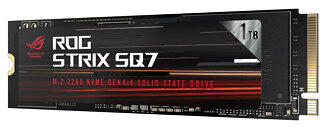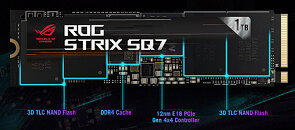TheLostSwede
News Editor
- Joined
- Nov 11, 2004
- Messages
- 18,472 (2.47/day)
- Location
- Sweden
| System Name | Overlord Mk MLI |
|---|---|
| Processor | AMD Ryzen 7 7800X3D |
| Motherboard | Gigabyte X670E Aorus Master |
| Cooling | Noctua NH-D15 SE with offsets |
| Memory | 32GB Team T-Create Expert DDR5 6000 MHz @ CL30-34-34-68 |
| Video Card(s) | Gainward GeForce RTX 4080 Phantom GS |
| Storage | 1TB Solidigm P44 Pro, 2 TB Corsair MP600 Pro, 2TB Kingston KC3000 |
| Display(s) | Acer XV272K LVbmiipruzx 4K@160Hz |
| Case | Fractal Design Torrent Compact |
| Audio Device(s) | Corsair Virtuoso SE |
| Power Supply | be quiet! Pure Power 12 M 850 W |
| Mouse | Logitech G502 Lightspeed |
| Keyboard | Corsair K70 Max |
| Software | Windows 10 Pro |
| Benchmark Scores | https://valid.x86.fr/yfsd9w |
Just under a month ago, ASUS posted a teaser for its first internal SSD, the ROG Strix SQ7 and now the company has finally released the full specs. It is indeed based around the 12 nm Phison E18 controller, as predicted by our Editor-In-Chief, something he spotted from the sneak peek picture. Although ASUS didn't specifically mention what kind of flash the drive is using, they kindly left the flash model number visible in one of its pictures of the drive. Although the full model name isn't visible, enough of it is visible to identify it as Micron's 176-layer TLC flash. The ROG Strix SQ7 also sports a DDR4 cache, as expected, although ASUS doesn't mention clock speeds.
ASUS claims the drive will deliver sequential read speeds of up to 7000 MB/s and write speeds of up to 6000 MB/s, which places the ROG Strix SQ7 in direct competition with several other Phison E18 based high-end drives from the likes of Kingston, MSI, Sabrent and others. Unfortunately, ASUS doesn't mention IOPS or random performance, although an unspecified "large" SLC cache is mentioned. Other features include TGC Opal and AES 256-bit encryption. ASUS also provides its own SSD dashboard, which of course is ROG branded, but looks like a skinned version of Phison's standard SSD dashboard, rather than something custom made. ASUS also provides a copy of NTI Backup Now EZ software and the drives appear to have a five year warranty. ASUS mentions PS5 compatibility outside of the PC space. No word on pricing or retail availability was provided and so far ASUS has only listed a 1 TB model.


View at TechPowerUp Main Site | Source
ASUS claims the drive will deliver sequential read speeds of up to 7000 MB/s and write speeds of up to 6000 MB/s, which places the ROG Strix SQ7 in direct competition with several other Phison E18 based high-end drives from the likes of Kingston, MSI, Sabrent and others. Unfortunately, ASUS doesn't mention IOPS or random performance, although an unspecified "large" SLC cache is mentioned. Other features include TGC Opal and AES 256-bit encryption. ASUS also provides its own SSD dashboard, which of course is ROG branded, but looks like a skinned version of Phison's standard SSD dashboard, rather than something custom made. ASUS also provides a copy of NTI Backup Now EZ software and the drives appear to have a five year warranty. ASUS mentions PS5 compatibility outside of the PC space. No word on pricing or retail availability was provided and so far ASUS has only listed a 1 TB model.


View at TechPowerUp Main Site | Source






